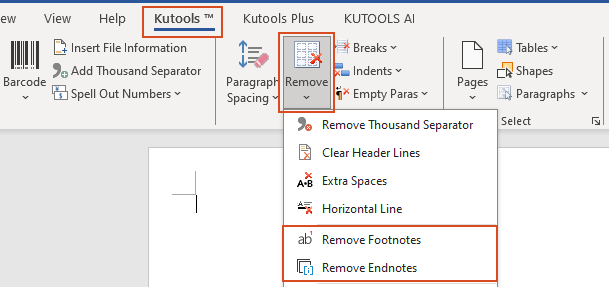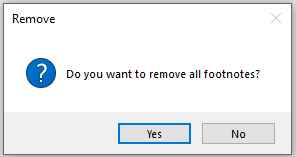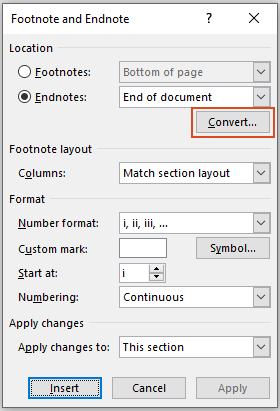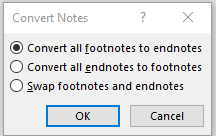How to add a footnote and endnote in Word? (Full guide)
Microsoft Word is a powerful tool for document creation and offers a variety of formatting options, including the use of footnotes and endnotes. These are essential for academic writing, providing additional information such as citations or comments without disrupting the flow of the main text. Typically, footnotes appear at the bottom of each page, while endnotes come at the end of the document or section. Other than their placement, they function similarly. This guide covers everything you need to know about inserting, formatting, and removing footnotes and endnotes in Word, along with answers to common questions.

Insert Footnotes and Endnotes in Word
To enhance your documents with supplementary information without overcrowding the main text, follow these steps to insert footnotes or endnotes in Microsoft Word.
1. Position the cursor within your document content where you want to reference a footnote or endnote.

2. On the References tab, select Insert Footnote or Insert Endnote.

Note: Alternatively, you can press Ctrl + Alt + F to create a footnote, or Ctrl + Alt + D to create an endnote.
3. Enter what you want in the footnote or endnote.
- After Step 2, Word inserts a superscript number at the cursor's location.
- Then you are immediately transported to the bottom of the page (Footnote) or the end of the section or document (Endnote). The footnote or endnote number will be inserted, and a separator bar will also be added. Your cursor will automatically be taken to the right of the footnote or endnote number so that you can fill it out. Type the text for the footnote or endnote. Here I take the footnote as an example.


4. To return to editing in the document, double-click the footnote or endnote number will take you directly to the superscripted number inserted in your document.

Repeat the above steps to add more footnotes and endnotes as you need.
- By hovering the mouse pointer over the superscripted number in the document text, you can preview the contents of a footnote or endnote.
- There is no need to type the notes’ number manually, following the procedures above will give automatic, consecutive numbering. So, when you add or delete notes, the numbers of the other footnotes or endnotes will be renumbered automatically.

🌟 AI Assistant for Word: Rewrite, Compose, and Summarize 🌟
Save time and effort with Kutools for Word's AI Assistant feature! 🚀
Rewrite: Refining content to enhance clarity and maintain professionalism

Compose: Developing tailored content to meet your specific needs

Summarize: Concisely summarizing documents and promptly addressing your questions

📊 Kutools for Word: Chosen by over 18,000 users. Enjoy a full-featured FREE trial with no credit card required! 🚀
Customize Footnotes and Endnotes in Word
Once you’ve added footnotes and/or endnotes, you can customize the way they appear and behave. This involves adjusting their location, layout, formatting, and numbering… to enhance readability and ensure they meet the specific citation guidelines required for your document. In this section, we'll explain how to effectively modify these elements in Microsoft Word.
Step 1: Open the Footnote and Endnote dialog box
Click on the Footnotes group dialog box launcher (a square with an arrow in the corner) on the References tab to open the Footnote and Endnote dialog box.

Step 2: In the Footnote and Endnote dialog box, adjust the options the way you want
Location:
- Select either the Footnotes or Endnotes option.
- Click the Location list arrow and choose where the footnotes and endnotes appear.
- Options for Footnotes include Bottom of page or Beneath text.
- For Endnotes, you can choose End of section or End of document.

Footnote layout:
Click the Columns list arrow to select the number of columns in which you want your footnotes or endnotes to appear.
It can be set to Match section layout or configured to a different number of columns to distinguish the notes section from the main body of text.

Format:
Under this section, you can choose a number format or custom symbol to mark footnotes or endnotes, select a starting number, and control whether numbering restarts on every page or new section.
- Number format: Select a numbering style such as Arabic numbers, Roman numerals, or letters from the Number format drop-down list.
- Custom mark: If you prefer not to use standard numbering, click on Symbol to choose a specific character or symbol to denote your footnotes or endnotes.
- Start at: It allows you to customize the starting number or character for your footnotes or endnotes.
- Numbering: Choose how the numbering should proceed. Options include:
- Continuous: Footnote or endnote numbers continue from the previous section.
- Restart each section: Numbering starts over in each new section.
- Restart each page (footnotes only): Numbering starts over on each new page.

Apply changes:
Click the Apply changes to list arrow to choose whether the options you’re applying affect the whole document or just the selected section.

Result
Click the Apply button. Then the selected options are applied to footnotes or endnotes, in the selected section or across the entire document.
Remove Footnotes and Endnotes in Word
Sometimes you may need to delete individual footnotes or endnotes, or you might want to remove them all from the document. This section will guide you through the process for both scenarios, ensuring you can efficiently manage the footnotes and endnotes in Microsoft Word.
Delete a footnote or endnote
To remove a specific footnote or endnote, simply highlight the superscripted number in the document text. And press the Delete key.

Note: Do not select the footnote number or text in the footnote at the bottom of the page to delete the footnote. Because the superscript number in the document will be left in document. This also applies to endnotes.
Result
You can see the number and text of the footnote or endnote will be deleted, along with the superscripted number in the document.
Delete All Footnotes or Endnotes
There are occasions when you may need to remove all footnotes or endnotes from a document. This can be accomplished through two primary methods.
- Method 1: Remove all footnotes or endnotes using the Find and Replace feature
- Method 2: One click to remove all footnotes or endnotes using Kutools for Word
Method 1: Remove all footnotes or endnotes using the Find and Replace feature
The Find and Replace feature in Word can be used to delete all footnotes or endnotes. Press Ctrl + H to open the Find and Replace dialog box, then please do as follows.
Note: In Word for Mac, on the Edit menu, click Find >Advanced Find and Replace.
- Click the Replace tab.
- In the Find what box, enter^ffor finding footnotes, or ^e for finding endnotes.
- Make sure the Replace with box is blank.
- Click the Replace All button.

Result
All footnotes or endnotes will be removed from your document.
Method 2: One click to remove all footnotes or endnotes using Kutools for Word
For a faster, more user-friendly approach, Kutools for Word provides a one-click solution that drastically simplifies the removal of footnotes and endnotes. Unlike the Find and Replace feature in Word, which requires knowledge of specific codes and careful manipulation to avoid affecting unintended text, Kutools allows users to eliminate all footnotes or endnotes with a single click. By selecting either 'Remove Footnotes' or 'Remove Endnotes' from the Kutools tab, you can instantly clear all notes from your document, ensuring a streamlined and error-free cleanup. This method not only saves time but also avoids the complexities and potential mistakes inherent in manual editing processes.
1. Go to the Kutools tab, and select Remove. In the drop-down menu, click Remove Footnotes or Remove Endnotes.

2. In the popping-up dialog box, click Yes.

Result
Then all footnotes or endnotes will be deleted from your document in just one click, without the need for manual deletion of each one!
Footnote vs Endnote
Both footnotes and endnotes serve crucial roles in enhancing textual content by offering additional information, citing sources, or acknowledging contributions without disrupting the narrative flow of the main document. In this section, we will explore both the similarities and the distinctions between footnotes and endnotes.
Similarities:
- Footnotes and endnotes are both used to place supplemental information for the text in the document.
- Footnotes and endnotes have two linked parts: the note reference mark (a number or a symbol), and corresponding text for the footnote or endnote. Word uses the note reference mark (usually a number) to associate the note with a reference point in the document.
Differences:
- A footnote appears at the bottom of each page of the document,
while an endnote comes at the end of the document or section of the document. - By default, footnotes are numbered with Arabic numerals (1, 2, 3, etc.).
By default, endnotes are numbered with Roman numerals (i, ii, iii, etc.).
The choice between footnotes and endnotes depends on your document's layout and the preference of your publication or educational institution.
Convert footnotes to endnotes in Word
Depending on your document's intended output or specific publication guidelines, you may find it necessary to convert footnotes to endnotes or vice versa. This section provides detailed instructions for making these conversions, whether you need to adjust a single note or modify all notes throughout the document.
Convert a footnote to an endnote or vice versa
Convert a footnote to an endnote:
Right-click on the footnote text at the bottom of the page, and select Convert to Endnote.

Convert an endnote to a footnote:
Right-click on the endnote text and choose Convert to Footnote.

Convert all footnotes to endnotes or vice versa
1. Click on the Footnotes group dialog box launcher (a square with an arrow in the corner) on the References tab.

2. In the Footnote and Endnote dialog box, click the Convert button in the Location section.

3. In the Convert Notes dialog box, choose one option from the 3 options provided. Click OK to apply the changes.
- Convert all footnotes to endnotes: This option will change every footnote in your document into an endnote.
It's useful when you need to consolidate notes at the end of the document for a cleaner page layout or specific publication requirements. - Convert all endnotes to footnotes: Selecting this will transform all endnotes in your document into footnotes.
This can be beneficial for readers, allowing them to access citations and additional information directly at the bottom of the page without flipping to the end of the document. - Swap footnotes and endnotes: This option swaps the positions of footnotes and endnotes. Footnotes become endnotes, and vice versa.
It offers a quick way to reposition annotations based on revised formatting or stylistic preferences.

Result
Word will convert all the notes accordingly and adjust the numbering across the document accordingly. Close the Footnote and Endnote dialog box as you need.
Common Q&A for Footnotes and Endnotes in Word
1. Why did my footnote go to the next page in Word?
Because the text where the footnote occurs is so far down on the page that if Word made room at the bottom for the footnote text, it would force the paragraph with the footnote to the next page. To fix this, you have to move your text around, so the footnote occurs further up on the page, or on the next page.
2. How do I insert more information into a footnote that already exists?
Go to the corresponding footnote at the bottom of the page. Once there, you can easily edit the footnote by typing additional information, modifying existing text, or formatting as needed.
3. How do I get my footnotes to restart at "1" with every new chapter?
In Microsoft Word, you can set your footnotes to restart at "1" with every new chapter by following these steps:
- Click on the References tab in the ribbon.
- In the Footnotes section, click on the Footnotes group dialog box launcher.
- In the Footnote and Endnote dialog box, go to the Format section.
- Click the Numbering list arrow, and select Restart each section from the drop-down list. Then click OK.
This will cause the footnotes to restart numbering at "1" with each new section or chapter in your document.
By understanding and utilizing footnotes and endnotes effectively in Microsoft Word, you can significantly enhance the readability and credibility of your documents, whether they are academic papers, books, or official reports. For more Word tips and tricks, please click here to access our extensive collection of hundreds of tutorials.
Related articles
How to view all footnotes from a Word document?
Now, you would like to view all the footnotes at same time without scrolling the pages one by one. How could you solve this job in Word document?
How to remove the footnote/endnote separator line in Word document?
When inserting footnotes or endnotes in Word document, you will find there is always a horizontal separator line above the footnote or endnotes texts. If you want to get rid of these separator lines, please try methods in this article.
How to select all footnotes in a Word document?
Normally, when selecting the whole Word document with Ctrl + A keys, all footnotes will be excluded from the selection. If you just want to select all footnotes in the document, how can you do? This article provides three methods for you to solve this problem.
How to convert comments to footnotes or endnotes in Microsoft Word?
Supposing there are multiple comments in your Word document, how can you convert all these comments to footnotes or endnotes at the same time? This article provides VBA methods to achieve it.
Best Office Productivity Tools
Kutools for Word - Elevate Your Word Experience
🤖 Kutools AI Features: AI Assistant / Real-Time Assistant / Super Polish (Preserve Format) / Super Translate (Preserve Format) / AI Redaction / AI Proofread...
📘 Document Mastery: Split Pages / Merge Documents / Export Selection in Various Formats (PDF/TXT/DOC/HTML...) / Batch Convert to PDF...
✏ Contents Editing: Batch Find and Replace across Multiple Files / Resize All Pictures / Transpose Table Rows and Columns / Convert Table to Text...
🧹 Effortless Clean: Sweap away Extra Spaces / Section Breaks / Text Boxes / Hyperlinks / For more removing tools, head to the Remove group...
➕ Creative Inserts: Insert Thousand Separators / Check Boxes / Radio Buttons / QR Code / Barcode / Multiple Pictures / Discover more in the Insert group...
🔍 Precision Selections: Pinpoint Specific Pages / Tables / Shapes / Heading Paragraphs / Enhance navigation with more Select features...
⭐ Star Enhancements: Navigate to Any Location / Auto-Insert Repetitive Text / Toggle Between Document Windows / 11 Conversion Tools...
🌍 Supports 40+ Languages: Use Kutools in your preferred language – supports English, Spanish, German, French, Chinese, and 40+ others!

Office Tab - Tabs for Office, Power for You
- Enable tabbed editing and reading in Word, Excel, PowerPoint, Publisher, Access, Visio and Project.
- Open and create multiple documents in new tabs of the same window, rather than in new windows.
- Increases your productivity by 50%, and reduces hundreds of mouse clicks for you every day!

✨ Kutools for Office – One Installation, Five Powerful Tools!
Includes Office Tab Pro · Kutools for Excel · Kutools for Outlook · Kutools for Word · Kutools for PowerPoint
📦 Get all 5 tools in one suite | 🔗 Seamless integration with Microsoft Office | ⚡ Save time and boost productivity instantly
Best Office Productivity Tools
Kutools for Word - 100+ Tools for Word
- 🤖 Kutools AI Features: AI Assistant / Real-Time Assistant / Super Polish / Super Translate / AI Redaction / AI Proofread
- 📘 Document Mastery: Split Pages / Merge Documents / Batch Convert to PDF
- ✏ Contents Editing: Batch Find and Replace / Resize All Pictures
- 🧹 Effortless Clean: Remove Extra Spaces / Remove Section Breaks
- ➕ Creative Inserts: Insert Thousand Separators / Insert Check Boxes / Create QR Codes
- 🌍 Supports 40+ Languages: Kutools speaks your language – 40+ languages supported!
Table of contents
- Video: Add a footnote and endnote in Word
- Insert footnotes and endnotes in Word
- Customize footnotes and endnotes in Word
- Remove footnotes and endnotes in Word
- Delete a footnote or endnote
- Delete all footnotes or endnotes
- Footnote vs Endnote
- Convert footnotes to endnotes in Word
- Convert a footnote to an endnote or vice versa
- Convert all footnotes to endnotes or vice versa
- Common Q&A for footnotes and endnotes in Word
- Related articles
- The Best Office Productivity Tools
- Comments


